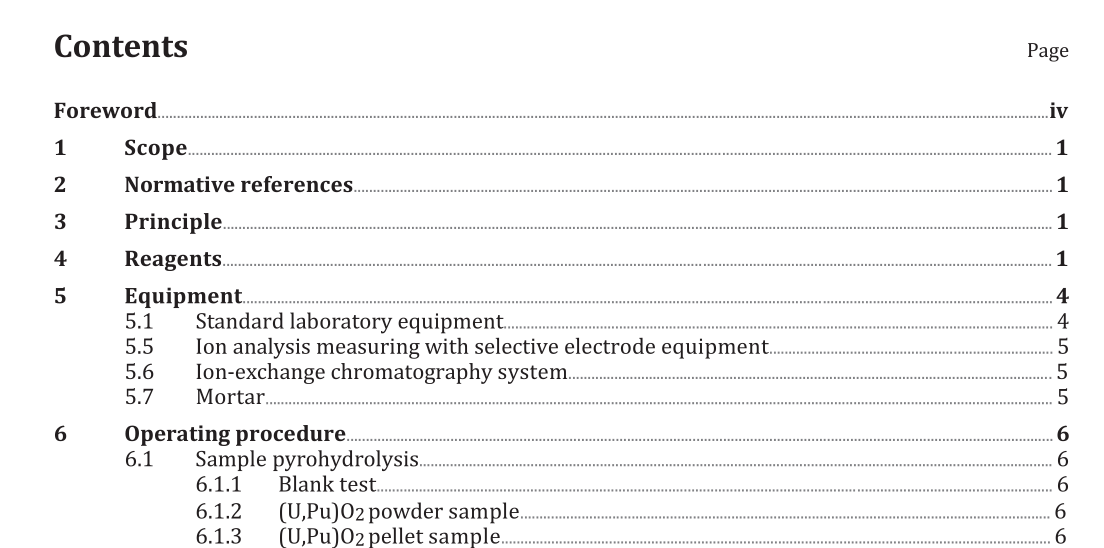BS ISO 21613:2015 pdf download.(U, Pu)O2 Powders and sintered pellets — Determination of chlorine and fluorine
1 Scope
This International Standard describes a method for determining chlorine and fluorine in mixed (U,Pu) O 2 powders and sintered pellets. It is applicable for the analysis of samples containing 5 µg.g −1 to 50 µg. g −1 of chlorine and 2 µg.g −1 to 50 µg.g −1 of fluorine.
For UO 2 powder and sintered pellets, refer to ISO 22875.
2 Normative references
The following documents, in whole or in part, are normatively referenced in this document and are indispensable for its application. For dated references, only the edition cited applies. For undated references, the latest edition of the referenced document (including any amendments) applies.
ISO 3696, Water for analytical laboratory use — Specification and test methods
ISO 22875, Nuclear energy — Determination of chlorine and fluorine in uranium dioxide powder and sintered pellets
ISO 9892, Uranium metal, uranium dioxide powder and pellets, and uranyl nitrate solutions — Determination of fluorine content — Fluoride ion selective electrode method
3 Principle
The samples are pyrohydrolyzed at 850 °C – 1 000 °C in a tubular furnace with steam or moist oxygen.Chlorine and fluorine are trapped as halogenated acids and entrained in an aqueous solution. Chloride and fluoride ions are measured using selective electrodes or another appropriate method, for instance,
ionic chromatography.
4 Reagents
Use only reagents of recognized analytical grade.
4.1 Demineralisedwater,complyingwithatleastgrade1inaccordancewithISO3696isrecommended.
4.2 Anhydrous sodium chloride (NaCl), analytical grade.
4.3 Anhydrous sodium fluoride (NaF), analytical grade.
4.4 Concentrated sodium hydroxide solution, w(NaOH) = 32 %, relative density approximately 1,35 g.ml −1 .
Concentrated sodium hydroxide solution (4.4) is used to prepare sodium hydroxide solutions (4.4.1,4.4.2, and 4.4.3). Concentrations of solutions (4.4.1, 4.4.2, and 4.4.3) are examples of reference solutions that are acceptable for use.
4.4.1 Sodium hydroxide solution, c(NaOH) = 5 mol.l −1 .
This reagent can also be prepared by using solid sodium hydroxide in various ways.
For example, the procedure can be as follows.
Pour 460 ml of concentrated sodium hydroxide solution (4.4) into 1 000 ml volumetric flask, dilute to the mark using demineralised water (4.1), and mix.
This reagent can also be prepared by dissolving solid sodium hydroxide (4.5) in solution using demineralised water (4.1).
4.4.2 Sodium hydroxide solution, c(NaOH) = 0,5 mol.l −1 .
Pour 46 ml of concentrated sodium hydroxide solution (4.4) into 1 000 ml volumetric flask, dilute to the mark using demineralised water (4.1), and mix.
4.4.3 Sodium hydroxide solution, c(NaOH) = 0,05 mol.l −1 .
Pour 100 ml of 0,5 mol/l −1 sodium hydroxide (4.4.2) into 1 000 ml volumetric flask, dilute to the mark using demineralised water (4.1), and mix.
4.4.4 Sodium hydroxide solution, c(NaOH) = 10 −4 mol.l −1 (or pH 10).
The concentration of solution (4.4.4) is an example of a receiver solution that can be used for a measurement by chromatography.
4.5 Anhydrous sodium hydroxide (NaOH), granules.
4.6 Glacial acetic acid, (CH 3 COOH), relative density approximately 1,06 g.ml −1 .
4.7 Sodium acetate, (CH 3 COONa) analytical grade.
BS ISO 21613:2015 pdf download
